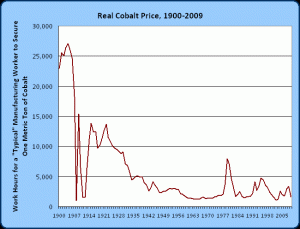Look at what has happened to the scarcity of cobalt over the past 100 years.
The top chart adjusts nominal cobalt prices to account for the general rise in prices since 1900 using a measure of the CPI’s broad inflation index. The bottom chart takes a different approach to adjust the cobalt data. It looks at the hourly wage of a typical manufacturing worker and asks how many hours would a typical worker need to work in order to secure a unit of cobalt.
(note, I imputed the hourly wages for 1915-1918). Cobalt data from USGS, CPI data from BLS and wage data from Historical Statistics of the United States and BLS.
By any metric, the scarcity of cobalt is no higher today (in fact, it is much lower) than it was over 100 years ago, even as human consumption of cobalt has rocketed with economic growth and population growth. In real terms, cobalt prices have fallen by 75% since 1900 from $126,659 per metric ton to $31,620 per metric ton today. In 1900, it took a typical manufacturing worker 22,994 work hours to secure himself a ton of cobalt. Today, a similar worker would only have to work 1,583 hours to get it – a decrease of over 93 percent over the course of the century. And as I will show you, these are lower bounds for just how scarce cobalt really has become. Cobalt prices would have to rise to $459,198 per metric ton to make it just as hard for a typical worker to get it today as it was in 1900. Alternately, if cobalt prices remain unchanged, the typical worker would have his pay slashed to just over $1.37 per hour in order to be in a position that his 1900 counterpart was in.
But this is just cobalt, right?

